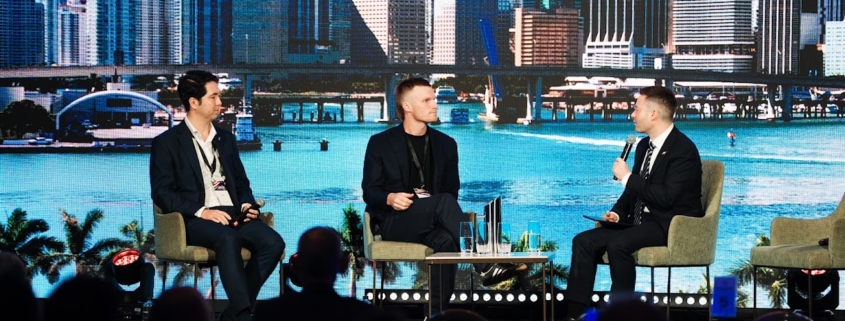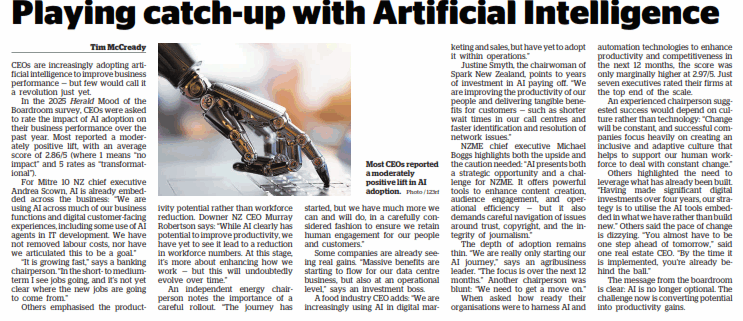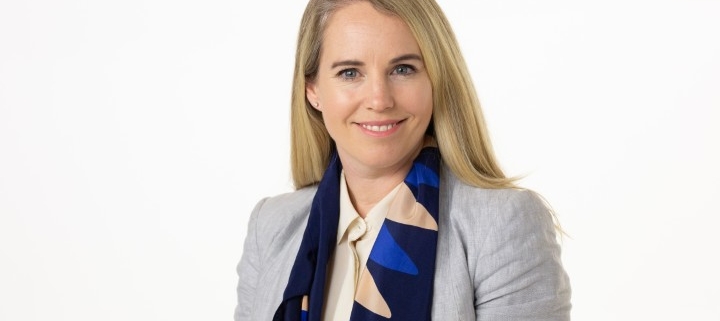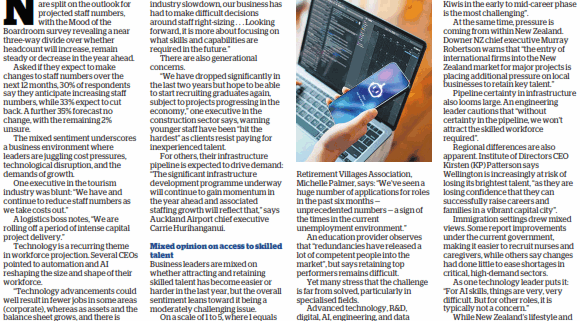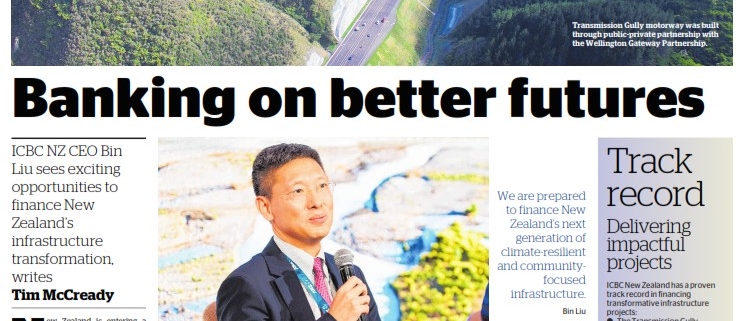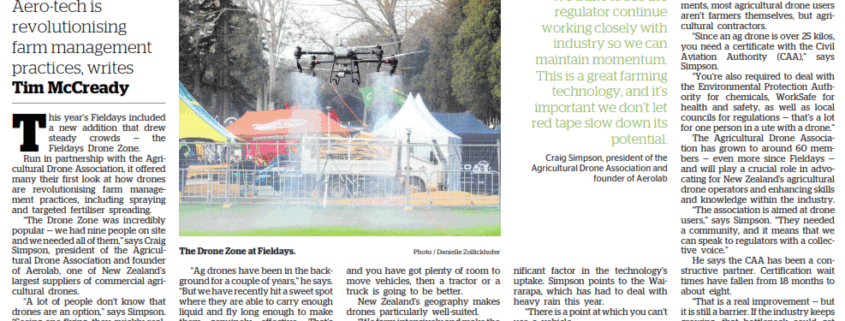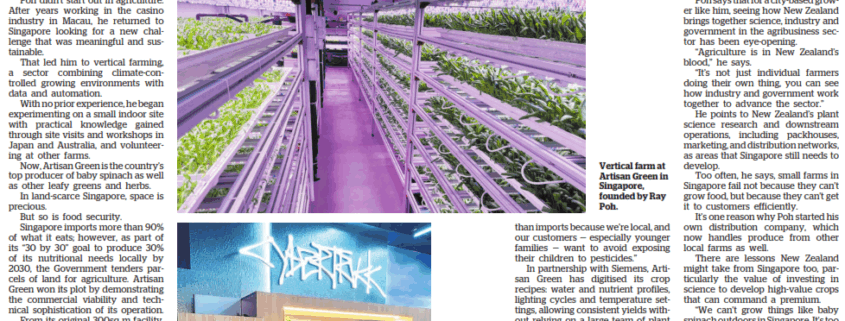Rocket Lab, Sky TV’s Sophie Moloney, Carmel Fisher big winners at the Deloitte Top 200 Awards
Rocket Lab, Sky TV CEO Sophie Moloney and financial services pioneer Carmel Fisher headlined this year’s Deloitte Top 200 Awards, one of the most anticipated events in New Zealand’s corporate calendar.
With the theme “Celebrating those who move Aotearoa forward”, the black-tie gala at Auckland’s Viaduct Events Centre brought together more than 800 business leaders, politicians and media. Hosted by Jack Tame and Stacey Morrison, the evening recognised outstanding performance, decisive leadership and the organisations driving New Zealand’s economic future.
Rocket Lab was the night’s standout, winning Company of the Year for a performance that has redefined what is possible for a New Zealand business on the global stage.
Its Nasdaq-listed share price doubled over the past year, giving the company a recent market capitalisation of US$21 billion, and its order book has swelled beyond US$500m as demand grows for both its Electron and next-generation Neutron rockets.
Strategic acquisitions in the United States and Europe have expanded Rocket Lab’s capabilities into areas such as missile tracking and laser communications, broadening its footprint and vertical integration across the space industry.
This year also saw a milestone interplanetary mission send two Rocket Lab spacecraft to Mars. The mission will help scientists better understand how the Red Planet lost its atmosphere.
The panel of high-profile judges, convened by NZME’s Fran O’Sullivan, praised Rocket Lab for securing a rare global leadership position for a New Zealand company, saying its success is “inspiring our next generation of young engineering and science talent”.
Sky chief executive Sophie Moloney is this year’s Chief Executive of the Year, recognised for reshaping the company through a people-first strategy and her ability to act decisively during a string of transformative deals.
After early-year turbulence from satellite issues, Sky delivered major strategic wins – including the $1 acquisition of Three and ThreeNow from Warner Bros, a five-year rugby rights deal, and Olympic broadcasting rights through to 2032. Judges say Moloney’s leadership helped propel Sky’s share price to five-year highs and restore investor confidence.
The only award that is given without finalists — the Visionary Leader — went to Carmel Fisher, honoured for her pioneering work in the financial services industry.
Fisher began investing in the early 1980s and quickly earned a strong reputation through a series of roles.
In 1998, she and her husband Hugh launched Fisher Funds from home with $17m in seed capital from Sovereign, making investing accessible through low minimums and nationwide town hall roadshows. The firm grew from a single managed fund to more than $25b in assets under management and 500,000 clients.
Judges describe Fisher as a trailblazer, and Fisher Funds chief executive Simon Power says her influence remains “present and enduring”, even after she stepped back from day-to-day leadership in 2017 following nearly two decades at the helm.
A2 Milk’s David Muscat, named Chief Financial Officer of the Year, was recognised for steering the dual-listed milk and infant formula company through a complex series of transactions.
Muscat oversaw the acquisition of Yashili’s Pōkeno plant, the sale of Mataura Valley Milk and the establishment of a long-term supply agreement with Fonterra. Operating across multiple markets and with significant exposure to the renminbi, he has built a finance function that supports disciplined decision-making and transparent investor communication.
Judges praise his humility, competence and “extraordinary impact for a CFO”, noting his role in restoring confidence after the company’s 2020-21 earnings slump and helping deliver a 49% total shareholder return over the year to September.
Fonterra chairman Peter McBride was named Chairperson of the Year, recognising his calm and unifying governance during a period of significant strategic change for New Zealand’s largest exporter. This is a rare repeat win in this category, with McBride also taking out the award in 2018 during his time chairing Zespri – underscoring a governance career defined by clarity, stability and deep commitment to New Zealand’s primary sector.
Since taking the role in 2020, McBride has guided the co-op through capital structure reform, strong performance, and the landmark $4.22b sale of its consumer brands to Lactalis. Fonterra delivered a $1.079b net profit this year, with strong performance from its high-value ingredients business.
Judges say McBride has rebuilt shareholder trust and ended factionalism on the board, highlighting the significant farmer support for the 2021 capital reform vote as a turning point.
Fisher & Paykel Healthcare won Best Growth Strategy for its long-term, organic approach that has seen the company double revenue every five to six years without relying on acquisitions.
It posted $2.021b in revenue and $377m in net profit this year, driven by its respiratory care products and sleep apnoea technology. With more than 1000 R&D staff and $226.9m invested in R&D, the company maintains a tight strategic focus.
Judges praise its clarity, discipline and willingness to plan decades ahead as it expands manufacturing in Auckland and overseas, calling it a model of innovation-led, patient, long-horizon growth.
Tower won Most Improved Performance for its transformation that delivered on both digital execution and financial growth.
The major transformation replaced legacy technology systems with a single modern, cloud-based digital platform across New Zealand and its Pacific markets, streamlining operations and enabling sophisticated risk-based pricing.
Air New Zealand’s Kate Boyer, named Young Executive of the Year, impressed judges with her energy, drive, and rapid impact as GM Airports, a role she stepped into at age 30.
She inherited a complex operation still recovering from the pandemic, with more than half the workforce newly hired and considerable leadership instability. Three weeks into the job, a spike in serious near-miss airport incidents required immediate action.
Boyer led a safety reset that reduced serious incidents by 60% and launched an Airport Champions Network to bridge the gap between agile product development and day-to-day operations. She also implemented productivity improvements that saved more than $10m while improving engagement.
Judges say her leadership maturity, people-first approach, and execution at scale place her firmly on a trajectory towards senior executive roles.
Precinct Properties took home the Sustainability Leadership award for a commercially grounded approach that has begun to shift practices across the construction sector.
Judges highlight its influence over contractors and suppliers, as well as its long-standing partnership with Ngāti Whātua Ōrākei.
Energy group Clarus received the Diversity & Inclusion Leadership award for its Building Belonging programme, launched in 2022 to create a workplace where everyone feels connected, supported and empowered.
The initiative strengthened foundations through online training, campaigns on topics like neurodiversity, and team values workshops. D&I was also added to every manager’s performance plan.
It introduced targeted workstreams for women, Māori and older workers, with gender-neutral recruitment, improved parental leave and early-career pathways. It has also more than halved the gender pay gap and lifted female hiring from 29% to 43%.
Judges praise the programme’s maturity, authenticity and strong executive sponsorship.
O’Sullivan is stepping down this year after 12 years as a judge and as convenor of the judging panel, a tenure defined by her rigorousness, independence and commitment to celebrating the best of New Zealand business excellence.
The Deloitte Top 200 Index consists of New Zealand’s largest entities ranked by revenue. These include publicly listed companies, large unlisted entities, New Zealand subsidiaries and branches of overseas companies and the commercial operations of Māori entities; also producer boards, co-operatives, local authority trading enterprises and state-owned enterprises.
An overview of the Top 200 Index – along with New Zealand’s Top 30 finance companies – is provided at the end of this report, including detailed analysis of revenue, profitability, efficiency and other key performance metrics. Together, these figures offer a clear snapshot of how New
Zealand’s largest organisations are performing, supported by commentary from the Herald’s business reporting team.
The high-level view of the Top 200 this year shows steady but subdued growth. Total revenues rose 2.1%, a slower pace than the previous two years, while underlying earnings (Ebitda) increased 5.1%. Profit after tax rebounded strongly, rising 23.7% and reversing last year’s 57.2% decrease.
ANZ remains the largest bank by a wide margin, with $199b in assets — more than $63b ahead of second-placed Westpac. ANZ also continues to lead the sector in both profitability and equity.
Deloitte Top 200: Sustainability Leadership Award 2025 - Precinct
Precinct has won the Deloitte Top 200 Sustainability Leadership award for 2025, recognising its ambitious, commercially grounded and sector-shaping approach to sustainability in the built environment.
A finalist last year, Precinct impressed judges with the breadth of its activity and the way it continues to evolve its sustainability efforts.
They highlight Precinct’s climate adaptation and operational resilience plans, and its commitment to working collaboratively to tackle challenges that no single organisation can address alone. Judges also note the recent expansion of Precinct’s sustainability team as further evidence of its commitment to long-term impact.
“Precinct’s sustainability initiatives are underpinned by a strong business case for why such actions add value to the company,” says Deloitte Top 200 sustainability judge Katie Beith. “It has also made good headway in influencing contractors and suppliers to source locally and sustainably – and is incentivising them to reduce emissions if they want to be eligible for future contracts.”
Precinct’s head of sustainability, Lisa Hinde, says sustainability is a core element of Precinct’s strategy, taking a long-term view that delivers enduring value for clients, investors and the wider community.
“It isn’t just the right thing to do, our track record shows it goes hand in hand with commercial success, ensuring our portfolio retains its value for future generations,” she says. This commercially grounded approach was highlighted by the judges as a standout feature of Precinct’s performance this year.
Recognising that a significant contributor to emissions in property development occurs during construction, Precinct has prioritised understanding and measuring embodied carbon.
It publishes upfront data for assessed development projects, ensuring visibility and accountability on its journey to net zero. Its most advanced project in this space, the Deloitte Centre development, achieved a 67% reduction in embodied carbon. The judges praise Precinct’s innovative methods for understanding and reducing embodied carbon – an area where it is helping set the pace.
“Precinct is proud to lead on addressing upfront embodied carbon in our development projects, which makes up more than 50% of annual emissions,” says Hinde.
“The biggest challenge is influencing emissions across our value chain, where we don’t have such direct control, but it’s also where we can create the greatest impact through procurement.”
Precinct is also progressing a broader initiative to decarbonise key construction materials, including steel, concrete and aluminium – with 10-year annual step-down targets planned from FY26.
In 2025, Precinct improved its score in the Global Real Estate Sustainability Benchmark to 91 out of 100, retaining its position for the second year running in the top 20% of more than 2000 participating funds and entities.
Earlier this year, Precinct development Beca House – New Zealand’s largest urban regeneration project – achieved a 6-star “World Leadership” Green Star Design rating. The building hosts Precinct’s largest rooftop solar array, part of a total 309kW of rooftop solar across Auckland’s Wynyard Quarter. The Deloitte Centre, Te Kaha, also received a 6-star certification – the first mixed-use office and hotel development in New Zealand to do so. These projects demonstrate how adaptive reuse (Deloitte Centre) and high-performance design can deliver strong commercial and sustainability outcomes.
Precinct also delivered New Zealand’s first NABERSNZ water ratings, achieving 4.5 to 5 stars across four commercial office buildings.
In FY25, Precinct introduced a national waste management strategy across its full portfolio to support a transition to circular economy principles. Through its quarterly ESG reporting programme, it shares energy, water and waste data with clients and runs workshops to support tenants in estimating their first NABERSNZ tenancy ratings – reflecting its commitment to sector-wide capability building.
Judges also recognise Precinct’s long-standing partnership with mana whenua, demonstrating its approach to partnership grounded in Te Tiriti o Waitangi and mana whenua engagement. It has formed a joint venture with Ngāti Whātua Ōrākei, alongside global investor PAG, to invest in the regeneration of the Te Tōangaroa precinct in Auckland’s city centre.
“Our partnerships with mana whenua are fundamental to our purpose and performance,” says Hinde. “They uphold cultural integrity, foster inclusive design, and strengthen our supply chain to deliver social and environmental outcomes that matter to the communities we serve.”
She says it is rewarding to see the mutually beneficial outcomes these relationships bring, from joint venture ownership to cultural advisory roles, service provision, and enduring connections that enrich both the built environment and society.
The judges commend Precinct’s focused and commercial approach to sustainability: “Precinct is focused on where it can achieve impact within its own value chain, how this adds value to the business and how it can drive progress across the broader sector.”
Its work continues to set benchmarks in sustainable property development – by reducing carbon as well as reshaping how commercial buildings are designed, delivered, and operated in New Zealand.
The Sustainability Leadership award is sponsored by Credibl.
Finalist: BNZ
Bank of New Zealand (BNZ) has been named a finalist for Sustainability Leadership, recognised for the depth and breadth of its approach, and its strong commitment to long-term resilience.
At the heart of BNZ’s strategy is Te Pae Tawhiti, a name that reflects a distant horizon and inter-generational mindset. Launched in 2020, it has two core pillars: Kaitiakitanga, focused on accelerating a just transition to a net-zero emissions economy that supports building back nature, and Manaakitanga, aimed at enhancing the long-term well-being of New Zealanders.
The judges note that BNZ is impressive for the comprehensiveness of its approach: “It is commendable to see it holding firm on commitments when other international banks are walking away.”
BNZ chief sustainability officer, Rebekah Cain, says the bank set ambitious targets when it committed to supporting customers to build a regenerative, resilient, and inclusive future.
“Climate impacts are real and are impacting our business and our customers now; they are crystallising faster than anticipated. It makes commercial sense to continue to support our customers and communities to adapt to those impacts and to stay relevant to international markets.”
Judges also highlight that “ensuring a healthy, growing and thriving business into the future is a core motivator,” noting BNZ’s focus on long-term resilience.
BNZ has set 2030 decarbonisation targets across high-emitting sectors including energy, residential real estate and agriculture, and is on track to meet its commitment to exit all lending to thermal coal mining by the end of 2025 – and all remaining coal mining-related lending by 2030.
“We recognise the important role that guidance, frameworks, and local laws have played in helping us build capability, plan, and set emissions targets,” says Cain. “These measures have set us on a pathway to help New Zealand reach net zero by 2050.”
In FY24, operational emissions were down 49% from 2019, with 96% of the bank’s purchased electricity needs sourced from renewables.
BNZ is also supporting customers in transition-exposed industries. Judges note the bank “is engaging to support customers in transition‑exposed industries, including acute challenges like energy resilience, with ESG fully integrated into the credit process.”
It has delivered $8.8 billion in sustainable finance since 2020 and aims to reach $10b this year. An additional $93m in green consumer lending in FY24 has helped over 2300 households to electrify transport or improve home resilience and efficiency.
“We’re confident we’ll surpass our $10b sustainable finance target in 2025,” says Cain. “Over the past five years, this lending has supported our customers, who represent a variety of sectors, to build models of resilience, and invest in things like energy efficiency, sustainable product innovation, water infrastructure and irrigation, preventing pollution, protecting and restoring biodiversity, social housing, and diversification of land.”
BNZ is also demonstrating leadership in nature regeneration. The BNZ Foundation supports biodiversity efforts such as depositing green-lipped mussels in the Hauraki Gulf as part of the “Revive Our Gulf” restoration project, and is a leading partner of the Aotearoa Circle, advancing sustainability through cross-sector collaboration.
The bank continues to invest in financial well-being and inclusion, having delivered $42.4 million in no- or low-interest loans to disrupt predatory lending and assisting over 350,000 New Zealanders to become scam-savvy through targeted education and tools.
BNZ’s integrated strategy positions it as a leader among New Zealand’s financial institutions, focused on creating long-term value for customers, communities and the environment.
Finalist: Goodman Property Trust
Goodman Property Trust (GMT) has been recognised as a finalist for its bold and forward-looking approach to sustainability leadership and its decision to press ahead with new emissions targets despite growing uncertainty in global markets.
As a long-term property investor, GMT’s decision-making is guided by a business strategy that aims to deliver positive outcomes for all its stakeholders. It includes targets for a lower-carbon and more resilient portfolio.
Judges say GMT’s leadership was clear in its actions. “The key development in 2025 was setting science-based emissions reduction targets, including for embodied carbon, which reflects the vast majority of the company’s footprint. While this may not seem special on its own, it was done at a time when other companies were pulling back from net-zero aspirations.”
GMT’s CFO, Andy Eakin, who also has overall responsibility for the organisation’s sustainability efforts, says that confidence came from the depth of analysis behind the targets.
“A significant amount of work has been undertaken to align our 2030 carbon reduction pathway with science-based targets. Expert advice, supported by an independent review from Toitū, has provided confidence that while our targets are ambitious, they remain both credible and achievable.”
GMT’s updated emissions reduction targets include a 43% reduction in corporate emissions and a 30% reduction in embodied carbon intensity by 2030.
To help meet these goals, GMT launched an Embodied Carbon Innovation Fund (ECIF), using an internal carbon price to replace the purchase of offsets. This fund is directed toward lower-emission materials and construction techniques across future projects. The judges found this to be a key differentiator for the company in an emissions-intensive sector.
Eakin says the ECIF is already shifting the way GMT approaches construction.
“The fund allows us to think more broadly about development, looking at all aspects of the process and the specifics of individual projects. We have already invested in a new initiative to critically assess the materials efficiency of our current building design, which aims to reduce the amount of building materials required to deliver to our designs, reducing materials, cost and embodied carbon.”
GMT’s commitment to sustainable development includes targeting a minimum 5 Green Star Built rating for all new projects. Its FY25 development programme has seen three project completions, with a reduction in upfront embodied carbon of 27%. Its sustainability initiatives have included the installation of electrical submetering, customer and public EV chargers, LED lighting upgrades, rooftop solar energy systems, and water-saving technologies.
“Committing to a minimum 5 Green Star Built rating since 2021 reflects a base building standard that is both highly sustainable and operationally efficient,” says Eakin. “We’ve developed over $750 million of properties that have achieved 5 Star or World Leadership 6 Green Star Built ratings.” He adds that partnering closely with customers has been key to reducing emissions across both new developments and existing buildings.
Governance is central to GMT’s sustainability strategy. Progress is reviewed quarterly at board level, underpinned by a Sustainable Finance Framework that has enabled over $600m in green bonds and loans to date.
The judges also recognise GMT’s growing social and environmental efforts.
Employee retention is high at nearly 99%, with an engagement score of 87%. GMT maintains inclusive workplace policies and achieved 33% female representation across its board and executive team.
Biodiversity initiatives include native planting and urban regeneration, and features such as beehives across larger estates to enhance and protect the natural environment.
GMT’s approach balances ambition with delivery, showing that climate leadership is possible even amid economic headwinds. Judges say this “embodies courageous leadership, and a board willing to take bold decisions on sustainability.”
Mood of the Boardroom: Playing catch-up with Artificial Intelligence (NZ Herald)
Mood of the Boardroom: Playing catch-up with Artificial Intelligence (NZ Herald)
CEOs are increasingly adopting artificial intelligence to improve business performance — but few would call it a revolution just yet.
In the 2025 Herald Mood of the Boardroom survey, CEOs were asked to rate the impact of AI adoption on their business performance over the past year. Most reported a moderately positive lift, with an average score of 2.86/5 (where 1 means “no impact” and 5 rates as “transformational”).
For Mitre 10 NZ chief executive Andrea Scown, AI is already embedded across the business: “We are using AI across much of our business functions and digital customer-facing experiences, including some use of AI agents in IT development. We have not removed labour costs, nor have we articulated this to be a goal.”
“It is growing fast,” says a banking chairperson. “In the short- to medium-term I see jobs going, and it’s not yet clear where the new jobs are going to come from.”
Others emphasised the productivity potential rather than workforce reduction. Downer NZ CEO Murray Robertson says: “While AI clearly has potential to improve productivity, we have yet to see it lead to a reduction in workforce numbers. At this stage, it’s more about enhancing how we work — but this will undoubtedly evolve over time.”
An independent energy chairperson notes the importance of a careful rollout. “The journey has started, but we have much more we can and will do, in a carefully considered fashion to ensure we retain human engagement for our people and customers.”
Some companies are already seeing real gains. “Massive benefits are starting to flow for our data centre business, but also at an operational level,” says an investment boss.
A food industry CEO adds: “We are increasingly using AI in digital marketing and sales, but have yet to adopt it within operations.”
Justine Smyth, the chairwoman of Spark New Zealand, points to years of investment in AI paying off. “We are improving the productivity of our people and delivering tangible benefits for customers — such as shorter wait times in our call centres and faster identification and resolution of network issues.”
NZME chief executive Michael Boggs highlights both the upside and the caution needed: “AI presents both a strategic opportunity and a challenge for NZME. It offers powerful tools to enhance content creation, audience engagement, and operational efficiency — but it also demands careful navigation of issues around trust, copyright, and the integrity of journalism.”
The depth of adoption remains thin. “We are really only starting our AI journey,” says an agribusiness leader. “The focus is over the next 12 months.” Another chairperson was blunt: “We need to get a move on.”
When asked how ready their organisations were to harness AI and automation technologies to enhance productivity and competitiveness in the next 12 months, the score was only marginally higher at 2.97/5. Just seven executives rated their firms at the top end of the scale.
An experienced chairperson suggested success would depend on culture rather than technology: “Change will be constant, and successful companies focus heavily on creating an inclusive and adaptive culture that helps to support our human workforce to deal with constant change.”
Others highlighted the need to leverage what has already been built. “Having made significant digital investments over four years, our strategy is to utilise the AI tools embedded in what we have rather than build new.” Others said the pace of change is dizzying. “You almost have to be one step ahead of tomorrow,” said one real estate CEO. “By the time it is implemented, you’re already behind the ball.”
The message from the boardroom is clear: AI is no longer optional. The challenge now is converting potential into productivity gains.
New NZIBF director outlines exporters’ response to tariffs
New NZIBF director outlines exporters’ response to tariffs
The New Zealand International Business Forum (NZIBF) has entered a new chapter of leadership, with Felicity Roxburgh stepping in as executive director at a time of heightened geopolitical uncertainty.
Roxburgh brings almost 20 years’ experience in trade and foreign policy. She has served in senior roles at the Ministry of Foreign Affairs and Trade, with postings in Hong Kong, New York and in the Pacific. Most recently, she was New Zealand’s Consul-General in New Caledonia, and before that led the business programme at the Asia New Zealand Foundation. She succeeds Stephen Jacobi who helped establish NZIBF in 2007.
Roxburgh had little time to ease into the role. Just weeks after joining the Forum she was fronting 15 media interviews on the United States’ sudden 15% tariff on New Zealand goods.
“There is a large appetite to understand what is happening in clear, simple terms and the impact on our exporters,” she says. “People knew the tariffs were going to impact us, but they didn’t know how or why.”
One of her top priorities is ensuring the fast-moving responses of business are better understood.
“Companies are responding to tariffs, supply chain disruption and investment uncertainty in real time”. Whether through scenario planning, diversifying into new markets or passing on costs to importers and consumers, she says these real-time adjustments are often invisible in high-level policy discussions, yet they are vital for resilience and competitiveness.
She is also focused on the future of New Zealand’s free trade agenda. Roxburgh points out that while New Zealand benefits from a dense “elaborate spaghetti network of free trade agreements”, gaps remain. “India and the US are the big missing pieces,” she says, noting that the government is putting huge investment into growing the India relationship and negotiating an FTA.
“At the same time, behind-the-border barriers — non-tariff costs — hit our exporters up to $10 billion a year. It’s a huge challenge.”
She also sees real opportunity in major trade blocs deepening collaboration. “If the Comprehensive and Progressive Agreement for Trans-Pacific Partnership (CPTPP) and the European Union were to do something together — and with us being a member of the CPTPP — it would be around 30% of the global trade. That’s one to watch.”
For Roxburgh, NZIBF’s role in the current climate is clear: to amplify exporters’ experience and work with the Government to push forward on market access.
“What does a business response look like to geopolitical uncertainty? Scenario planning, diversification, pricing changes, working with partners. These are practical steps companies are taking, and that’s the story we need to tell.”
Mood of the Boardroom: Boardrooms split on staff as AI reshapes workforce (NZ Herald)
Mood of the Boardroom: Boardrooms split on staff as AI reshapes workforce (NZ Herald)
New Zealand’s boardrooms are split on the outlook for projected staff numbers, with the Mood of the Boardroom survey revealing a near three-way divide over whether headcount will increase, remain steady or decrease in the year ahead.
Asked if they expect to make changes to staff numbers over the next 12 months, 30% of respondents say they anticipate increasing staff numbers, while 33% expect to cut back. A further 35% forecast no change, with the remaining 2% unsure.
The mixed sentiment underscores a business environment where leaders are juggling cost pressures, technological disruption, and the demands of growth.
One executive in the tourism industry was blunt: “We have and continue to reduce staff numbers as we take costs out.”
A logistics boss notes, “We are rolling off a period of intense capital project delivery.”
Technology is a recurring theme in workforce projection. Several CEOs pointed to automation and AI reshaping the size and shape of their workforce.
“Technology advancements could well result in fewer jobs in some areas (corporate), whereas as assets and the balance sheet grows, and there is more development and construction going on, the workforce is likely to increase,” says one experienced chairperson.
Others spoke of balancing efficiency with future capability.
“We’ll continue to adjust resources to match demand and ensure the business stays efficient — focusing on keeping essential roles while scaling back where necessary,” says Anne Gaze, of Campus Link Foundation.
Some businesses remain in contraction mode. The CEO of an engineering firm says: “Due to the industry slowdown, our business has had to make difficult decisions around staff right-sizing … Looking forward, it is more about focusing on what skills and capabilities are required in the future.”
There are also generational concerns.
“We have dropped significantly in the last two years but hope to be able to start recruiting graduates again, subject to projects progressing in the economy,” one executive in the construction sector says, warning younger staff have been “hit the hardest” as clients resist paying for inexperienced talent.
For others, their infrastructure pipeline is expected to drive demand: “The significant infrastructure development programme underway will continue to gain momentum in the year ahead and associated staffing growth will reflect that,” says Auckland Airport chief executive Carrie Hurihanganui.
Mixed opinion on access to skilled talent
Business leaders are mixed on whether attracting and retaining skilled talent has become easier or harder in the last year, but the overall sentiment leans toward it being a moderately challenging issue.
On a scale of 1 to 5, where 1 equals very difficult and 5 equals very easy, the average score was 2.95/5.
For some, access to skilled labour has eased in the past year, with a softer economy and higher unemployment increasing the pool of available candidates.
Several note they are receiving record numbers of applications, describing the current climate as an “employer’s market”.
Executive director of the Retirement Villages Association, Michelle Palmer, says: “We’ve seen a huge number of applications for roles in the past six months — unprecedented numbers — a sign of the times in the current unemployment environment.”
An education provider observes that “redundancies have released a lot of competent people into the market”, but says retaining top performers remains difficult.
Yet many stress that the challenge is far from solved, particularly in specialised fields.
Advanced technology, R&D, digital, AI, engineering, and data analytics are all cited as areas where skills are scarce.
The lure of higher wages in Australia and beyond features prominently, with multiple executives highlighting a “flight to Australia” across professions including law, health, and infrastructure.
One leader describes it as “alarming”, while another says young lawyers are now departing earlier in their careers than ever before.
Cordis managing director Craig Bonnor adds that “talent retention of Kiwis in the early to mid-career phase is the most challenging”.
At the same time, pressure is coming from within New Zealand. Downer NZ chief executive Murray Robertson warns that “the entry of international firms into the New Zealand market for major projects is placing additional pressure on local businesses to retain key talent.”
Pipeline certainty in infrastructure also looms large. An engineering leader cautions that “without certainty in the pipeline, we won’t attract the skilled workforce required”.
Regional differences are also apparent. Institute of Directors CEO Kirsten (KP) Patterson says Wellington is increasingly at risk of losing its brightest talent, “as they are losing confidence that they can successfully raise careers and families in a vibrant capital city”.
Immigration settings drew mixed views. Some report improvements under the current government, making it easier to recruit nurses and caregivers, while others say changes had done little to ease shortages in critical, high-demand sectors.
As one technology leader puts it: “For AI skills, things are very, very difficult. But for other roles, it is typically not a concern.”
While New Zealand’s lifestyle and reputation for innovation continue to draw talent, executives stress that retention depends on competitive pay, career development, and building purpose-driven organisations.
As Harcourts managing director Bryan Thomson sums up: “The business world relies on talent acquisition and retention.
“Now as always, this is the number one challenge for every leader.”
ICBC NZ CEO Bin Liu sees exciting opportunities to finance New Zealand’s infrastructure transformation, writes Tim McCready
New Zealand is entering a critical new phase of infrastructure development. Decades of underinvestment, rapid urban growth, and the increasing impacts of climate change have converged to create both a challenge and an opportunity.
ICBC New Zealand, a subsidiary of the world’s largest bank by total assets and capital, sees compelling potential for Chinese capital to support this transformation. With more than 11 years of local operations, the bank draws on global experience and deep funding capability to deliver tailored, ESG-aligned financing solutions for New Zealand.
Speaking at the recent China Business Summit in Auckland, Bin Liu, CEO of ICBC New Zealand reflected on the state of the market.
“I have three key takeaways from the past year,” he said. “First, we are finally seeing more infrastructure projects moving — and at a bigger scale than before.
“Second, it’s the best time in the history of New Zealand’s infrastructure.
“We know that we have an infrastructure deficit. Everyone can feel it, especially in Auckland.
“But at the same time, for those of us working in the sector, we see the pipeline growing. We see government commitment, real movement, and more deals coming to market. That gives us confidence and opportunities to contribute.”
China’s infrastructure journey offers useful lessons about what’s possible when demand, planning, and funding align effectively. Liu outlines five key drivers that, in his view, have underpinned that success:
“First, decades of fast economic growth following China’s reform and opening-up policy created huge demand for infrastructure.
“Second, there has been strong government commitment and long-term strategic planning, supported by efficient execution.
“Third is China’s comprehensive industry system and skilled workforce. We have an integrated supply chain and a large pool of engineering talent and construction capacity.
“Fourth is our openness. China has consistently looked outward to adopt global technologies and best practices.
“And finally, dynamic funding solutions. We have a flexible and comprehensive financial system that enables sustainable infrastructure investment.”
While acknowledging that New Zealand and China operate in different contexts, Liu believes there are still valuable insights to draw from.
“It’s not about copying models, but about learning what works and adapting it locally. That’s where international collaboration can really add value. I believe there are opportunities for more Chinese expertise, capacity, technology and innovation to contribute to New Zealand’s infrastructure.”
It’s a message Liu has championed for some time. Back in 2019, ICBC helped facilitate a high-level delegation of public and private sector leaders from New Zealand’s infrastructure industry to China, organised by Infrastructure New Zealand. The programme in Shanghai and Beijing aimed to deepen sector-to-sector understanding.
“The connections and trust built between the infrastructure sectors of both countries during that trip were invaluable,” recalls Liu.
“It helped shift perception and highlight the potential for collaboration. That momentum was disrupted by Covid, but with infrastructure needs intensifying it is the right time to rebuild and strengthen those ties.”
Bridging global capital and local ambition
Liu says a useful lens for understanding what is possible is to look at what ICBC New Zealand is already doing here.
“Our focus spans four key areas: infrastructure, such as roads, ports, airports, energy, power and telecommunications; people’s welfare and development, including healthcare, aged care and education; businesses with trade and investment ties to China; and long-term asset development, particularly in property.”
He notes that the level of Chinese capital involvement varies across these sectors, but the opportunities are clear.
“ICBC Group has a presence in more than 49 countries, including flagship branches in major international financial centres,” Liu says.
“We can source funding from different financial markets using economic and efficient instruments. Overseas issuance and money market operations have become a very important part of ICBC New Zealand’s funding mix, allowing us to support local infrastructure projects effectively.”
Liu believes that New Zealand’s infrastructure landscape is poised for real progress.
“We are prepared to finance New Zealand’s next generation of climate-resilient and community-focused infrastructure,” he says.
“We’re not just banking for today, but for generations to come.”
Agribusiness and Trade: Drones transform NZ farms from above
- Drone use is growing in NZ, with around 60 members now in the Agricultural Drone Association.
- Drones fill a practical niche between ground-based equipment and helicopters.
- The association is working with the Civil Aviation Authority to improve the certification process.
This year’s Fieldays included a new addition that drew steady crowds – the Fieldays Drone Zone. Run in partnership with the Agricultural Drone Association, it offered many their first look at how drones are revolutionising farm management practices, including spraying and targeted fertiliser spreading.
“The Drone Zone was incredibly popular – we had nine people on site and we needed all of them,” says Craig Simpson, president of the Agricultural Drone Association and founder of Aerolab, New Zealand’s largest supplier of commercial agricultural drones.
“A lot of people don’t know that drones are an option,” says Simpson. “Seeing one flying, they quickly realise they are big machines that can carry a significant spray pack, and gain a better understanding of how they work.”
The use of drones is reshaping how work gets done on New Zealand farms, with significant growth over the last few years. There are now hundreds of large agricultural drones operating across the country – up from around 20 or 30 three years ago. Simpson says Aerolab’s sales have doubled in the past year alone.
“Ag drones have been in the background for a couple of years,” he says. “But we have recently hit a sweet spot where they are able to carry enough liquid and fly long enough to make them genuinely effective. That’s when the market really took off.”
Drones fill a practical niche between ground-based equipment and helicopters, and their rise is changing how agricultural contractors operate. They can open up access to land that might previously have been too steep or too wet for traditional agricultural machinery, or that require immediate attention and more precision.
“If you’ve got 100 hectares to do, a helicopter is always going to be the best choice,” he says. “And if you’ve got lots of ground, it is dry, not steep, and you have got plenty of room to move vehicles, then a tractor or a truck is going to be better.
New Zealand’s geography makes drones particularly well-suited.
“We farm intensively and make the most out of small holdings,” says Simpson. “We’ve got a lot of arable land but not a huge amount of it is flat. Even with beef and sheep, we run stock on quite steep country. A drone is a real nice fit.”
This is opening up new possibilities. “Some farmers never dealt with gorse on steep blocks because the only option was spraying with a backpack. A helicopter wasn’t economical. Now a drone contractor can do the job at a reasonable rate.”
Urgency has also become a significant factor in the technology’s uptake. Simpson points to Wairarapa, which has had to deal with heavy rain this year.
“There is a point at which you can’t use a vehicle. In the past you might ring a helicopter provider and be told there is a four-week wait. Meanwhile, the fungus gets a foothold.
“A drone provider might be the same price, but they can be there the next day. You can deal with the problem faster and ultimately use less chemicals.”
Safety is another driver of demand.
“Why drive a quad bike or a vehicle across a steep hillside when you can instead fly over it with a drone and keep everyone safe?” says Simpson.
Given the compliance requirements, most agricultural drone users aren’t farmers themselves, but agricultural contractors.
“Since an ag drone is over 25 kilos, you need a certificate with the Civil Aviation Authority (CAA),” says Simpson. “You’re also required to deal with the Environmental Protection Authority for chemicals, WorkSafe for health and safety, as well as local councils for regulations – that’s a lot for one person in a ute with a drone.”
The Agricultural Drone Association has grown to around 60 members – even more since Fieldays – and will play a crucial role in advocating for New Zealand’s agricultural drone operators and enhancing skills and knowledge within the industry.
“The association is aimed at drone users,” says Simpson. “They needed a community, and it means that we can speak to regulators with a collective voice.”
He says the CAA has been a constructive partner. Certification wait times have fallen from 18 months to about eight.
“That is a real improvement – but it is still a barrier. If the industry keeps growing, that bottleneck could get worse.
“We’d like to see the regulator continue working closely with industry so we can maintain momentum. This is a great farming technology, and it’s important we don’t let red tape slow down its potential.”
Simpson says that with their speed, precision, and ability to tackle challenging terrain, agricultural drones are on their way to becoming a familiar sight on New Zealand farms – not just a novelty attraction at Fieldays.
Agribusiness and Trade: Sustainable food innovator seeks inspiration from NZ
Ray Poh from one of Singapore’s leading vertical farms talks with Tim McCready about what he can learn from New Zealand’s agriculture sector.
Artisan Green, founded in 2018 by Ray Poh, is a high-tech, indoor farm that uses stacked growing systems, precision automation and plant science to produce pesticide-free leafy greens in the densely populated city-state.
Poh didn’t start out in agriculture. After years working in the casino industry in Macau, he returned to Singapore looking for a new challenge that was meaningful and sustainable.
That led him to vertical farming, a sector combining climate-controlled growing environments with data and automation. With no prior experience, he began experimenting on a small indoor site with practical knowledge gained through site visits and workshops in Japan and Australia, and volunteering at other farms.
Now, Artisan Green is the country’s top producer of baby spinach as well as other leafy greens and herbs.
In land-scarce Singapore, space is precious. But so is food security.
Singapore imports more than 90% of what it eats, however, as part of its “30 by 30″ goal to produce 30% of its nutritional needs locally by 2030, the Government tenders parcels of land for agriculture. Artisan Green won its plot by demonstrating the commercial viability and technical sophistication of its operation.
From its original 300 square metre facility, the company is preparing to move into a new two-hectare site in Singapore’s designated agriculture zone. The expansion includes a 5500sq m vertical farm, along with significant outdoor greenhouse space and a 4000sq m facility to support post-harvest operations.
This will lift production from one tonne a month to 30 tonnes per month in the initial phase. The second phase will see this increase to 90 tonnes per month.
Poh says the larger scale will allow Artisan Green to bring prices down and make the locally grown produce more competitive.
“Our aim is to price between overseas imports and imported organic produce,” he says. “People support us even though we’re more expensive than imports because we’re local, and our customers – especially younger families – want to avoid exposing their children to pesticides.”
In partnership with Siemens, Artisan Green has digitised its crop recipes: water and nutrient profiles, lighting cycles and temperature settings, allowing consistent yields without relying on a large team of plant scientists.
“We encapsulate the entire growing cycle into our recipes,” he says, “which means that anyone using this platform in the future will not have to be a plant scientist to operate it.”
Poh explains that the intellectual property developed will help make future expansion easier. With the science centralised and scalable, Artisan Green can replicate its model overseas using local workers, without having to bring in expensive technical talent.
He likens it to McDonald’s. “You don’t have chefs in McDonald’s. You just need operators, while all the R&D is done in the central kitchen.”
Poh was in New Zealand last month as part of the Asia New Zealand Foundation’s ASEAN Young Business Leaders Initiative programme.
The delegation of 11 agribusiness entrepreneurs visited businesses around the country and attended Fieldays to learn about New Zealand’s agricultural sector, build local connections, and explore future business opportunities.
Poh says that for a city-based grower like him, seeing how New Zealand brings together science, industry and government in the agribusiness sector has been eye-opening.
“Agriculture is in New Zealand’s blood,” he says. “It’s not just individual farmers doing their own thing, you can see how industry and government work together to advance the sector.”
He points to New Zealand’s plant science research and downstream operations, including packhouses, marketing, and distribution networks, as areas that Singapore still needs to develop.
Too often, he says, small farms in Singapore fail not because they can’t grow food, but because they can’t get it to customers efficiently. It’s one reason why Poh started his own distribution company, which now handles produce from other local farms as well.
There are lessons New Zealand might take from Singapore too, particularly the value of investing in science to develop high-value crops that can command a premium.
“We can’t grow things like baby spinach outdoors in Singapore. It’s too hot. So we grow it indoors. But to make that work, you need margins, and you need to grow something premium,” Poh says.
And you need to know your science.
“A lot of people think AI or automation is going to revolutionise agriculture. But you can’t eat software,” he says.
“So you need to know your basics in plant science first, then automate from there.”
Poh sees both countries as coming at the same problem from different angles. New Zealand has deep-rooted farming knowledge and strong science institutions. Singapore brings innovation in urban food production.
If the future of food is global, then the best ideas will likely grow in both places.
China Business Summit 2025: Nick Mowbray and Zuru
Nick Mowbray took us inside the “Just in Time” building revolution that Zuru Tech has sparked to disrupt the manufacture of homes and commercial buildings for international markets. Zuru Tech’s flagship product, DreamCatcher, is the world’s first BIM software directly connected to automated production systems, enabling users to design, price, and manufacture buildings with unprecedented efficiency and precision.
It’s the latest chapter in the Zuru story, which began over two decades ago in Guangzhou with a toy company founded by the Mowbray siblings, now a global powerhouse in innovation and scale.
Moderator: Tim McCready, Summit MC
—
The 2025 China Business Summit was held on 18 July 2025 at Cordis, Auckland.
Brought to you by NZ INC. and Auckland Business Chamber.

